
一、选择题 1.对牙髓最具有破坏性的是 A.Nd激光 A.C02激光 A.红激光 A.光固化灯 A.牙髓活力电测定仪 2.感染根管常见的优势菌不包括 A.普氏菌 B.放线菌 C.G+细菌 D.真杆菌 E.梭形杆菌 3.备洞时易损伤牙髓的因素不包括 A.施力大 B.用冷却剂 C.持续常时间钻磨 D.制备深的窝洞 E.不用冷却剂 4.与顽固性根尖周病变和窦道经久不愈可能有关的细菌为 A.普氏菌 B.放线菌 C.G+细菌 D. 真杆菌 E.梭形杆菌 5.判断牙髓活力最可靠的检查方法是 A.热诊 B.冷诊 C.牙髓活力电测定 D.试验性备洞 E.X线检查 6.诊断残髓炎最准确的依据是 A.叩诊 B.牙髓活力测试 C.病史 D.症状 E.探查治疗后根管有痛觉 7.急性根尖周脓肿最佳的排脓途径 A.从牙周间隙排脓 B.从颊、舌侧粘膜或皮肤排出 C. 经根管从龋洞排脓 D.从上颌窦或鼻腔排脓 E.以上都不对 8.感染侵入牙髓组织的途径
一、选择题 1. 对牙髓最具有破坏性的是 A. Nd 激光 A. CO2 激光 A. 红激光 A. 光固化灯 A. 牙髓活力电测定仪 2. 感染根管常见的优势菌不包括 A. 普氏菌 B. 放线菌 C. G +细菌 D. 真杆菌 E. 梭形杆菌 3.备洞时易损伤牙髓的因素不包括 A. 施力大 B. 用冷却剂 C. 持续常时间钻磨 D. 制备深的窝洞 E. 不用冷却剂 4.与顽固性根尖周病变和窦道经久不愈可能有关的细菌为 A. 普氏菌 B. 放线菌 C. G+细菌 D. 真杆菌 E. 梭形杆菌 5. 判断牙髓活力最可靠的检查方法是 A. 热诊 B. 冷诊 C. 牙髓活力电测定 D. 试验性备洞 E. X 线检查 6.诊断残髓炎最准确的依据是 A. 叩诊 B. 牙髓活力测试 C. 病史 D. 症状 E. 探查治疗后根管有痛觉 7.急性根尖周脓肿最佳的排脓途径 A. 从牙周间隙排脓 B. 从颊、舌侧粘膜或皮肤排出 C. 经根管从龋洞排脓 D. 从上颌窦或鼻腔排脓 E. 以上都不对 8.感染侵入牙髓组织的途径
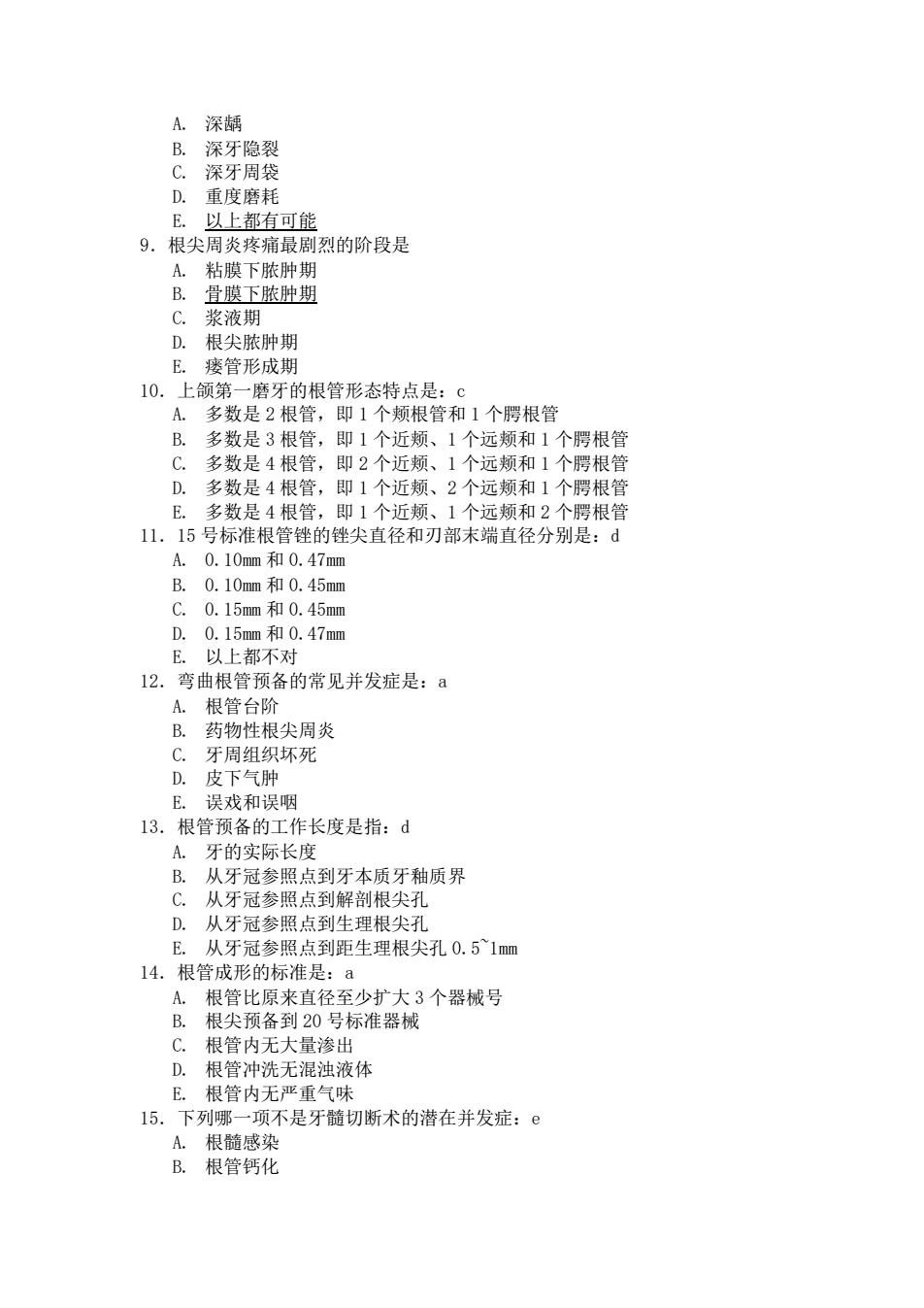
A.深龋 B. 深牙隐裂 C. 深牙周袋 D.重度磨耗 E.以上都有可能 9.根尖周炎疼痛最剧烈的阶段是 A. 粘膜下脓肿期 B.骨膜下脓肿期 C.浆液期 D. 根尖脓肿期 E.瘘管形成期 10.上颌第一磨牙的根管形态特点是:c A.多数是2根管,即1个颊根管和1个腭根管 B.多数是3根管,即1个近颊、1个远颊和1个腭根管 C.多数是4根管,即2个近颊、1个远颊和1个腭根管 D.多数是4根管,即1个近颊、2个远颊和1个腭根管 E.多数是4根管,即1个近颊、1个远颊和2个腭根管 11.15号标准根管锉的锉尖直径和刃部末端直径分别是:d A.0.10mm和0.47mm B.0.10mm和0.45mm C.0.15mm和0.45mm D.0.15mm和0.47mm E.以上都不对 l2.弯曲根管预备的常见并发症是:a A.根管台阶 B.药物性根尖周炎 C.牙周组织坏死 D. 皮下气肿 E.误戏和误咽 13.根管预备的工作长度是指:d A.牙的实际长度 B.从牙冠参照点到牙本质牙釉质界 C.从牙冠参照点到解剖根尖孔 D.从牙冠参照点到生理根尖孔 E.从牙冠参照点到距生理根尖孔0.51mm 14.根管成形的标准是:a A.根管比原来直径至少扩大3个器械号 B.根尖预备到20号标准器械 C.根管内无大量渗出 D.根管冲洗无混浊液体 E.根管内无严重气味 15.下列哪一项不是牙髓切断术的潜在并发症:e A.根髓感染 B.根管钙化
A. 深龋 B. 深牙隐裂 C. 深牙周袋 D. 重度磨耗 E. 以上都有可能 9.根尖周炎疼痛最剧烈的阶段是 A. 粘膜下脓肿期 B. 骨膜下脓肿期 C. 浆液期 D. 根尖脓肿期 E. 瘘管形成期 10.上颌第一磨牙的根管形态特点是:c A. 多数是 2 根管,即 1 个颊根管和 1 个腭根管 B. 多数是 3 根管,即 1 个近颊、1 个远颊和 1 个腭根管 C. 多数是 4 根管,即 2 个近颊、1 个远颊和 1 个腭根管 D. 多数是 4 根管,即 1 个近颊、2 个远颊和 1 个腭根管 E. 多数是 4 根管,即 1 个近颊、1 个远颊和 2 个腭根管 11.15 号标准根管锉的锉尖直径和刃部末端直径分别是:d A. 0.10mm 和 0.47mm B. 0.10mm 和 0.45mm C. 0.15mm 和 0.45mm D. 0.15mm 和 0.47mm E. 以上都不对 12.弯曲根管预备的常见并发症是:a A. 根管台阶 B. 药物性根尖周炎 C. 牙周组织坏死 D. 皮下气肿 E. 误戏和误咽 13.根管预备的工作长度是指:d A. 牙的实际长度 B. 从牙冠参照点到牙本质牙釉质界 C. 从牙冠参照点到解剖根尖孔 D. 从牙冠参照点到生理根尖孔 E. 从牙冠参照点到距生理根尖孔 0.5~1mm 14.根管成形的标准是:a A. 根管比原来直径至少扩大 3 个器械号 B. 根尖预备到 20 号标准器械 C. 根管内无大量渗出 D. 根管冲洗无混浊液体 E. 根管内无严重气味 15.下列哪一项不是牙髓切断术的潜在并发症:e A. 根髓感染 B. 根管钙化
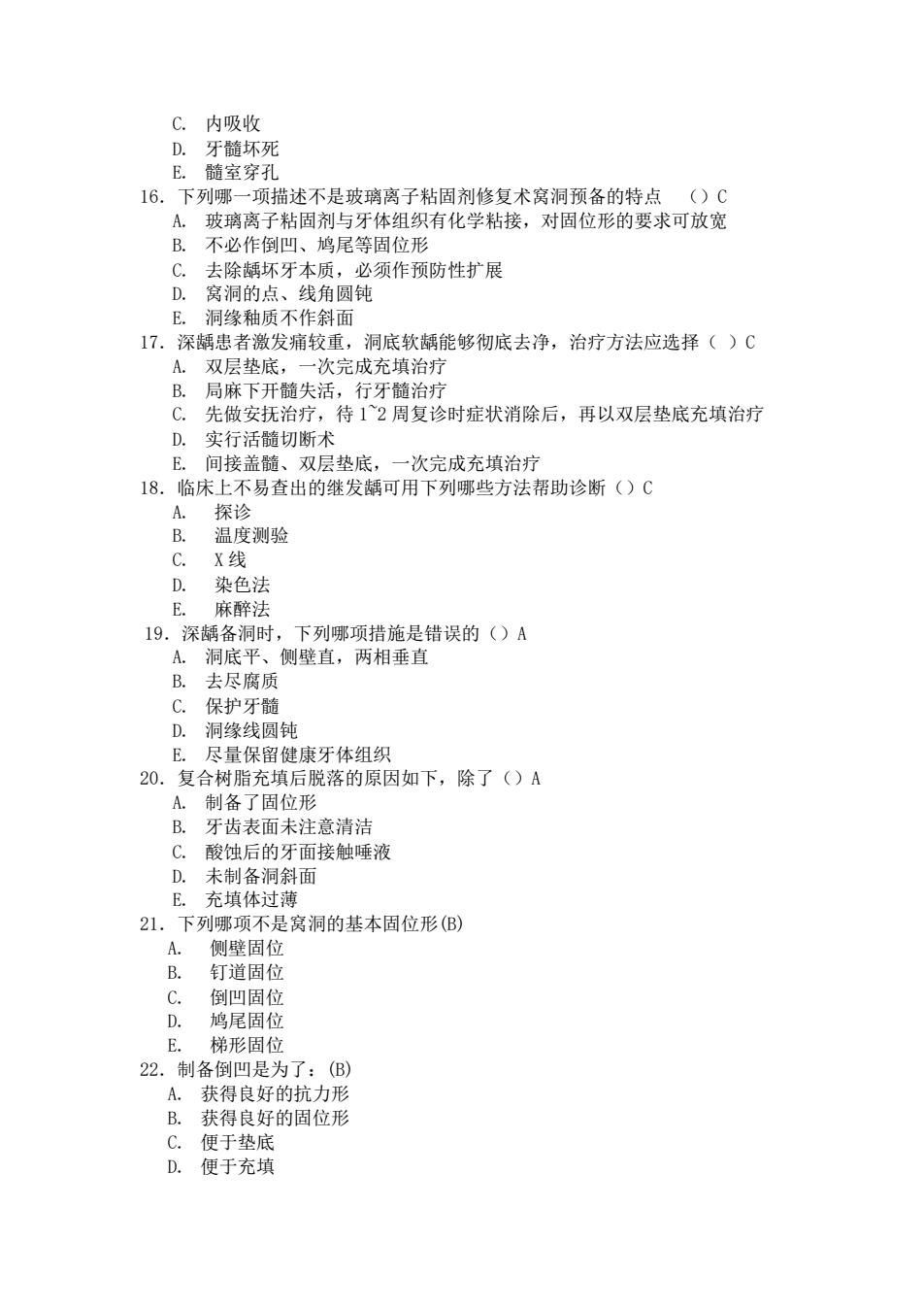
C.内吸收 D.牙髓坏死 E.髓室穿孔 16.下列哪一项描述不是玻璃离子粘固剂修复术窝洞预备的特点()C A.玻璃离子粘固剂与牙体组织有化学粘接,对固位形的要求可放宽 B.不必作倒凹、鸠尾等固位形 C. 去除龋坏牙本质,必须作预防性扩展 D.窝洞的点、线角圆钝 E.洞缘釉质不作斜面 17.深龋患者激发痛较重,洞底软龋能够彻底去净,治疗方法应选择()C A.双层垫底,一次完成充填治疗 B.局麻下开髓失活,行牙髓治疗 C.先做安抚治疗,待12周复诊时症状消除后,再以双层垫底充填治疗 D.实行活髓切断术 E.间接盖髓、双层垫底,一次完成充填治疗 18.临床上不易查出的继发龋可用下列哪些方法帮助诊断()C A. 探诊 8 温度测验 C. X线 D. 染色法 E.麻醉法 19.深龋备洞时,下列哪项措施是错误的()A A.洞底平、侧壁直,两相垂直 B.去尽腐质 C.保护牙髓 D.洞缘线圆钝 E.尽量保留健康牙体组织 20.复合树脂充填后脱落的原因如下,除了()A A.制备了固位形 B.牙齿表面未注意清洁 C.酸蚀后的牙面接触唾液 D.未制备洞斜面 E.充填体过薄 21.下列哪项不是窝洞的基本固位形(B) A. 侧壁固位 B. 钉道固位 C. 倒凹固位 D. 鸠尾固位 E. 梯形固位 22.制备倒凹是为了:(B) A.获得良好的抗力形 B.获得良好的固位形 C.便于垫底 D.便于充填
C. 内吸收 D. 牙髓坏死 E. 髓室穿孔 16.下列哪一项描述不是玻璃离子粘固剂修复术窝洞预备的特点 ()C A. 玻璃离子粘固剂与牙体组织有化学粘接,对固位形的要求可放宽 B. 不必作倒凹、鸠尾等固位形 C. 去除龋坏牙本质,必须作预防性扩展 D. 窝洞的点、线角圆钝 E. 洞缘釉质不作斜面 17.深龋患者激发痛较重,洞底软龋能够彻底去净,治疗方法应选择( )C A. 双层垫底,一次完成充填治疗 B. 局麻下开髓失活,行牙髓治疗 C. 先做安抚治疗,待 1~2 周复诊时症状消除后,再以双层垫底充填治疗 D. 实行活髓切断术 E. 间接盖髓、双层垫底,一次完成充填治疗 18.临床上不易查出的继发龋可用下列哪些方法帮助诊断()C A. 探诊 B. 温度测验 C. X 线 D. 染色法 E. 麻醉法 19.深龋备洞时,下列哪项措施是错误的()A A. 洞底平、侧壁直,两相垂直 B. 去尽腐质 C. 保护牙髓 D. 洞缘线圆钝 E. 尽量保留健康牙体组织 20.复合树脂充填后脱落的原因如下,除了()A A. 制备了固位形 B. 牙齿表面未注意清洁 C. 酸蚀后的牙面接触唾液 D. 未制备洞斜面 E. 充填体过薄 21.下列哪项不是窝洞的基本固位形(B) A. 侧壁固位 B. 钉道固位 C. 倒凹固位 D. 鸠尾固位 E. 梯形固位 22.制备倒凹是为了:(B) A. 获得良好的抗力形 B. 获得良好的固位形 C. 便于垫底 D. 便于充填
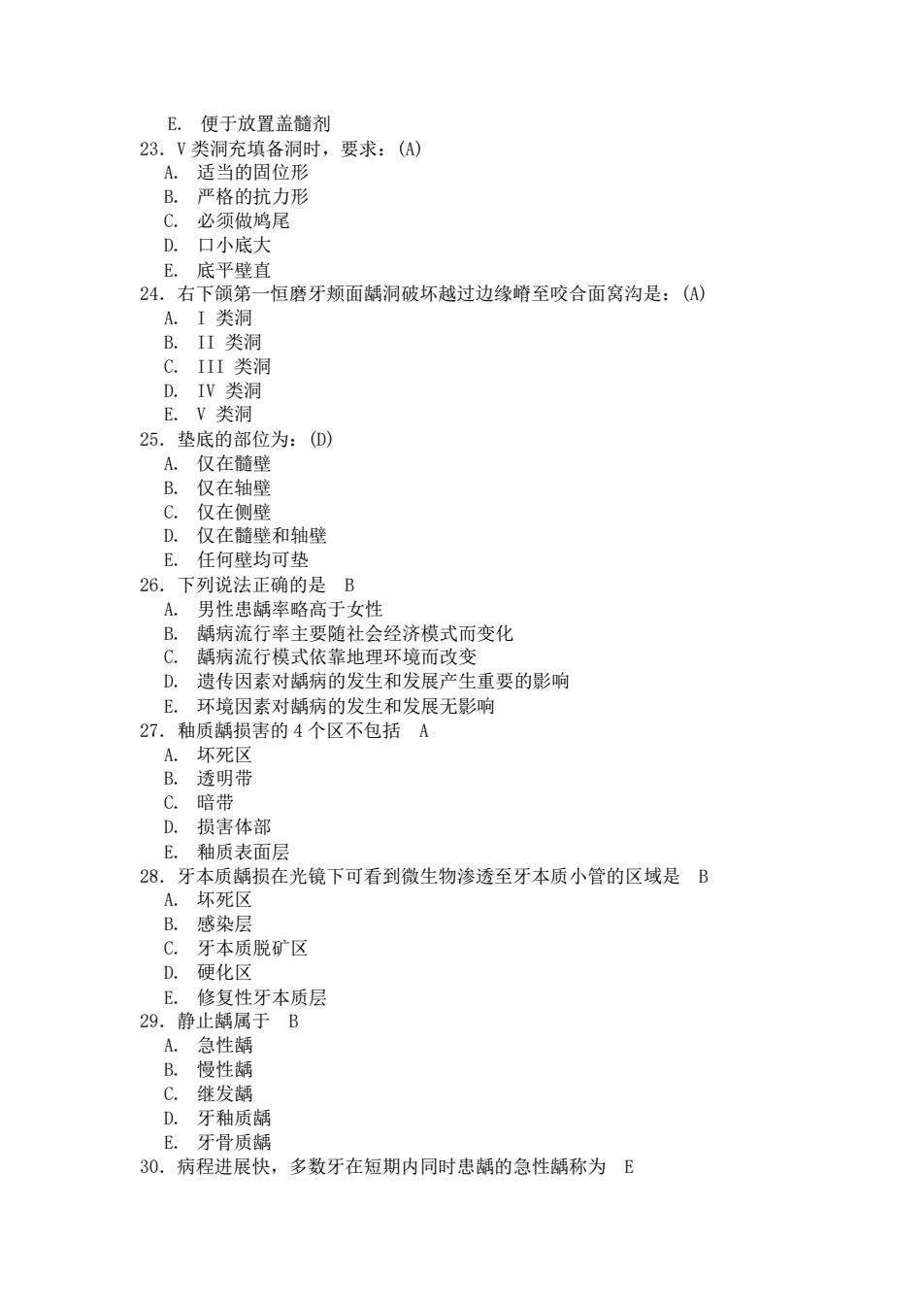
E.便于放置盖髓剂 23.V类洞充填备洞时,要求:(A) A. 适当的固位形 B.严格的抗力形 C. 必须做鸠尾 D. 口小底大 E.底平壁直 24.右下颌第一恒磨牙颊面龋洞破坏越过边缘嵴至咬合面窝沟是:(A) A.I类洞 B.II类洞 C.III类洞 D.IV类洞 E.V类洞 25.垫底的部位为:(D) A.仅在髓壁 B.仅在轴壁 C. 仅在侧壁 D. 仅在髓壁和轴壁 E. 任何壁均可垫 26.下列说法正确的是B A.男性患龋率略高于女性 B.龋病流行率主要随社会经济模式而变化 C. 龋病流行模式依靠地理环境而改变 D. 遗传因素对龋病的发生和发展产生重要的影响 E. 环境因素对龋病的发生和发展无影响 27.釉质龋损害的4个区不包括A A.坏死区 B.透明带 C.暗带 D.损害体部 E.釉质表面层 28.牙本质龋损在光镜下可看到微生物渗透至牙本质小管的区域是B A.坏死区 B.感染层 C.牙本质脱矿区 D.硬化区 E.修复性牙本质层 29.静止龋属于B A.急性龋 B.慢性龋 C. 继发龋 D.牙釉质龋 E.牙骨质龋 30.病程进展快,多数牙在短期内同时患龋的急性龋称为E
E. 便于放置盖髓剂 23.V 类洞充填备洞时,要求:(A) A. 适当的固位形 B. 严格的抗力形 C. 必须做鸠尾 D. 口小底大 E. 底平壁直 24.右下颌第一恒磨牙颊面龋洞破坏越过边缘嵴至咬合面窝沟是:(A) A. I 类洞 B. II 类洞 C. III 类洞 D. IV 类洞 E. V 类洞 25.垫底的部位为:(D) A. 仅在髓壁 B. 仅在轴壁 C. 仅在侧壁 D. 仅在髓壁和轴壁 E. 任何壁均可垫 26.下列说法正确的是 B A. 男性患龋率略高于女性 B. 龋病流行率主要随社会经济模式而变化 C. 龋病流行模式依靠地理环境而改变 D. 遗传因素对龋病的发生和发展产生重要的影响 E. 环境因素对龋病的发生和发展无影响 27.釉质龋损害的 4 个区不包括 A A. 坏死区 B. 透明带 C. 暗带 D. 损害体部 E. 釉质表面层 28.牙本质龋损在光镜下可看到微生物渗透至牙本质小管的区域是 B A. 坏死区 B. 感染层 C. 牙本质脱矿区 D. 硬化区 E. 修复性牙本质层 29.静止龋属于 B A. 急性龋 B. 慢性龋 C. 继发龋 D. 牙釉质龋 E. 牙骨质龋 30.病程进展快,多数牙在短期内同时患龋的急性龋称为 E
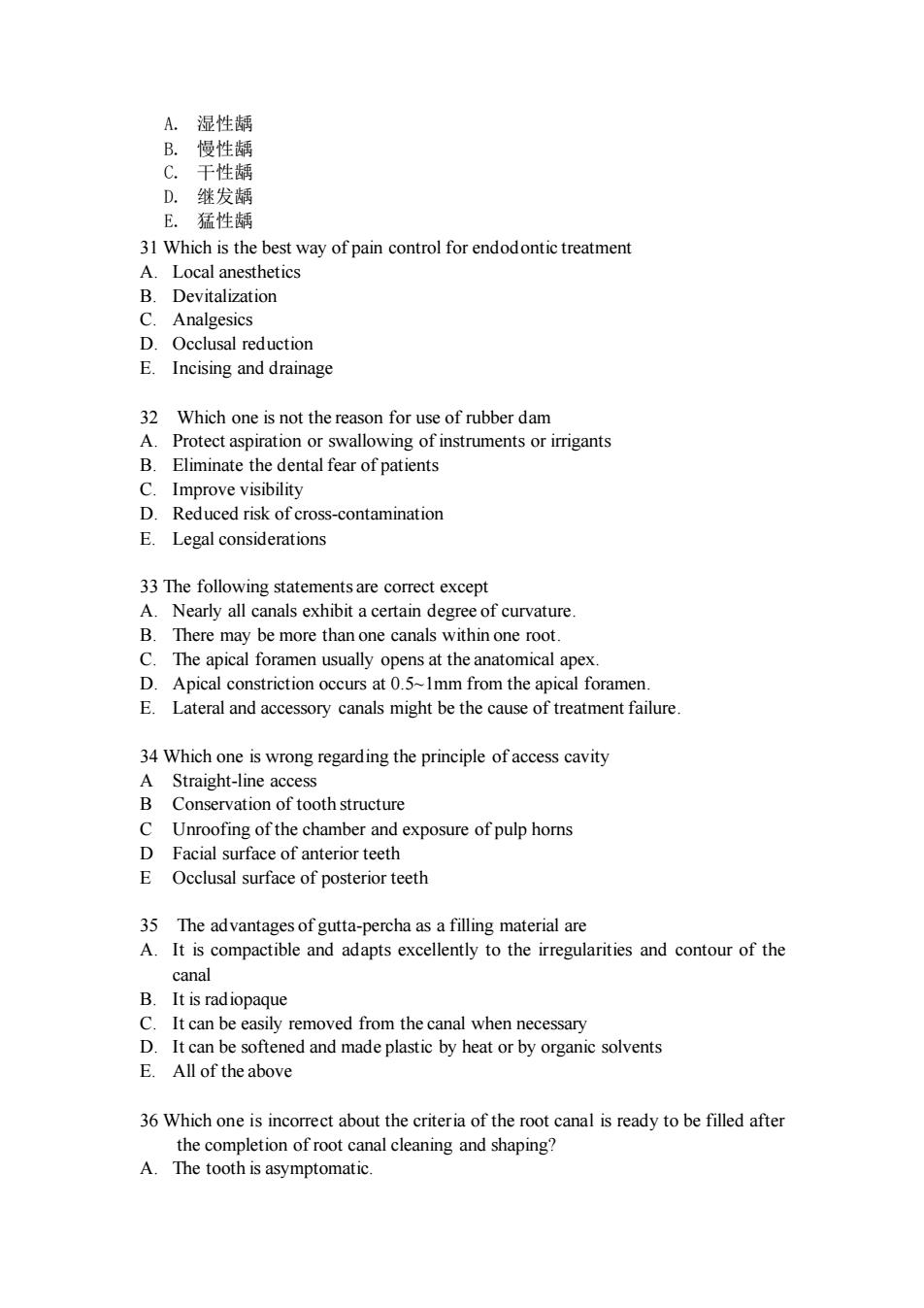
A. 湿性龋 B.慢性龋 C. 干性龋 D. 继发龋 E.猛性龋 31 Which is the best way of pain control for endodontic treatment A.Local anesthetics B.Devitalization C. Analgesics D. Occlusal reduction E.Incising and drainage 32 Which one is not the reason for use of rubber dam A.Protect aspiration or swallowing of instruments or irrigants B.Eliminate the dental fear of patients C.Improve visibility D.Reduced risk of cross-contamination E.Legal considerations 33 The following statements are correct except A.Nearly all canals exhibit a certain degree of curvature. B.There may be more than one canals within one root. C.The apical foramen usually opens at the anatomical apex. D.Apical constriction occurs at 0.5~1mm from the apical foramen E.Lateral and accessory canals might be the cause of treatment failure. 34 Which one is wrong regarding the principle of access cavity A Straight-line access B Conservation of tooth structure C Unroofing of the chamber and exposure of pulp horns D Facial surface of anterior teeth E Occlusal surface of posterior teeth 35 The ad vantages of gutta-percha as a filling material are A.It is compactible and adapts excellently to the irregularities and contour of the canal B.It is radiopaque C.It can be easily removed from the canal when necessary D.It can be softened and made plastic by heat or by organic solvents E.All of the above 36 Which one is incorrect about the criteria of the root canal is ready to be filled after the completion of root canal cleaning and shaping? A.The tooth is asymptomatic
A. 湿性龋 B. 慢性龋 C. 干性龋 D. 继发龋 E. 猛性龋 31 Which is the best way of pain control for endodontic treatment A. Local anesthetics B. Devitalization C. Analgesics D. Occlusal reduction E. Incising and drainage 32 Which one is not the reason for use of rubber dam A. Protect aspiration or swallowing of instruments or irrigants B. Eliminate the dental fear of patients C. Improve visibility D. Reduced risk of cross-contamination E. Legal considerations 33 The following statements are correct except A. Nearly all canals exhibit a certain degree of curvature. B. There may be more than one canals within one root. C. The apical foramen usually opens at the anatomical apex. D. Apical constriction occurs at 0.5~1mm from the apical foramen. E. Lateral and accessory canals might be the cause of treatment failure. 34 Which one is wrong regarding the principle of access cavity A Straight-line access B Conservation of tooth structure C Unroofing of the chamber and exposure of pulp horns D Facial surface of anterior teeth E Occlusal surface of posterior teeth 35 The advantages of gutta-percha as a filling material are A. It is compactible and adapts excellently to the irregularities and contour of the canal B. It is radiopaque C. It can be easily removed from the canal when necessary D. It can be softened and made plastic by heat or by organic solvents E. All of the above 36 Which one is incorrect about the criteria of the root canal is ready to be filled after the completion of root canal cleaning and shaping? A. The tooth is asymptomatic
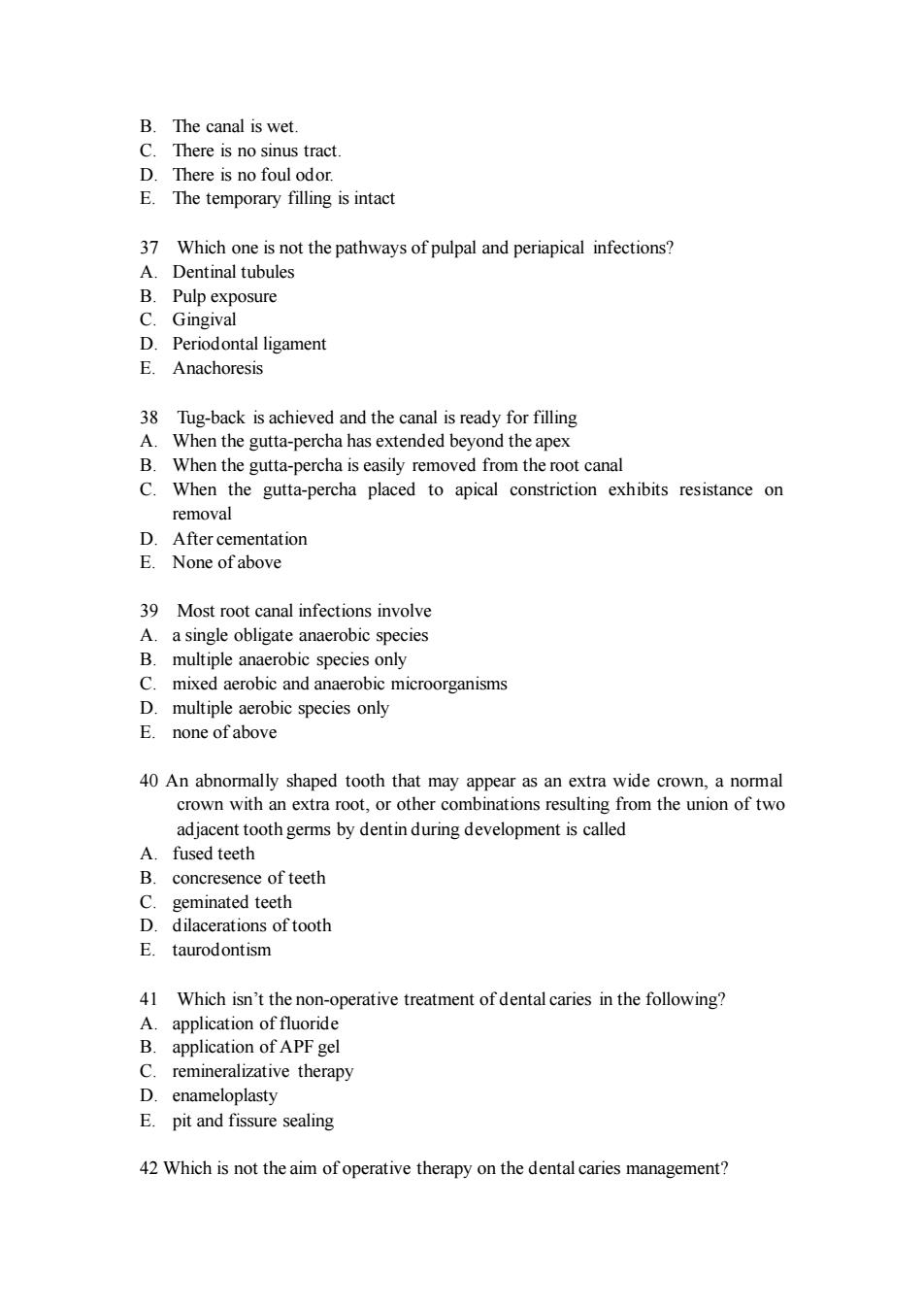
B.The canal is wet C.There is no sinus tract. D.There is no foul odor. E.The temporary filling is intact 37 Which one is not the pathways of pulpal and periapical infections? A.Dentinal tubules B.Pulp exposure C. Gingival D.Periodontal ligament E.Anachoresis 38 Tug-back is achieved and the canal is ready for filling A. When the gutta-percha has extended beyond the apex B.When the gutta-percha is easily removed from the root canal C.When the gutta-percha placed to apical constriction exhibits resistance on removal D.After cementation E.None ofabove 39 Most root canal infections involve A.a single obligate anaerobic species B.multiple anaerobic species only C.mixed aerobic and anaerobic microorganisms D.multiple aerobic species only E.none ofabove 40 An abnormally shaped tooth that may appear as an extra wide crown,a normal crown with an extra root,or other combinations resulting from the union of two adjacent tooth germs by dentin during development is called A.fused teeth B.concresence of teeth C.geminated teeth D.dilacerations of tooth E.taurodontism 41 Which isn't the non-operative treatment of dental caries in the following? A.application of fluoride B.application of APF gel C.remineralizative therapy D.enameloplasty E.pit and fissure sealing 42 Which is not the aim of operative therapy on the dental caries management?
B. The canal is wet. C. There is no sinus tract. D. There is no foul odor. E. The temporary filling is intact 37 Which one is not the pathways of pulpal and periapical infections? A. Dentinal tubules B. Pulp exposure C. Gingival D. Periodontal ligament E. Anachoresis 38 Tug-back is achieved and the canal is ready for filling A. When the gutta-percha has extended beyond the apex B. When the gutta-percha is easily removed from the root canal C. When the gutta-percha placed to apical constriction exhibits resistance on removal D. After cementation E. None of above 39 Most root canal infections involve A. a single obligate anaerobic species B. multiple anaerobic species only C. mixed aerobic and anaerobic microorganisms D. multiple aerobic species only E. none of above 40 An abnormally shaped tooth that may appear as an extra wide crown, a normal crown with an extra root, or other combinations resulting from the union of two adjacent tooth germs by dentin during development is called A. fused teeth B. concresence of teeth C. geminated teeth D. dilacerations of tooth E. taurodontism 41 Which isn’t the non-operative treatment of dental caries in the following? A. application of fluoride B. application of APF gel C. remineralizative therapy D. enameloplasty E. pit and fissure sealing 42 Which is not the aim of operative therapy on the dental caries management?

A.To remove infected dentine and prohibit caries B.To protect the pulp and avoid pain C.To enhance the strength of the tooth D.To facilitate plaque control E.To restore the appearance(of teeth)and its function 43 Which is the best statement about resistance form A.Resistance form is the design of a cavity in such a way that the remaining tooth substance and the restorative material can withstand masticatory stress B.The bulk required will depend on the flexural strength of restorative material.In the case of amalgam it is estimated that a minimum of 1.5-2mm thickness of the restorative material is required to withstand masticatory stress C.If a marginal ridge is found to be too weak in the cause of an occlusal cavity preparation,a Class II cavity may have to be prepared instead,so as to eliminate the weak marginal ridge.This is particularly indicated where the ridge is only of enamel thickness and unsupported by sound dentine D.The cavity should be designed that the occlusal margins of the cavity are in areas not subjected to excessive occlusal trauma,otherwise the enamel wall of the cavity and/or the margins of the restorative material may fracture.In practice,this may be achieved by placing an occlusal margins of a cavity about one-quarter (1/4)of the intercuspal distance.Note,that efforts should always be made to conserve sound tooth tissue E.All of the above 44 Which is the most danger area of tooth in dental caries occurred after you have learned dental caries? A.Pits and fissures on occlusal surfaces of molars and premolars B.Approximal surfaces of all teeth. C.Gingival thirds of all teeth,both on facial and lingual surfaces D.Pits and fissures near the lingual of maxillary incisors and canines (lingual pits) E.Pits and fissures on the buccal of molars 45 Which is not true in the following statement about dental caries and micro-organisms? A.Caries could be induced by specific bacteria,especially mutans streptococci-group (eg.Streptococcus mutans and Strep.sobrinus). B.There are caries occurred when only fed a cariogenic (high sucrose)diet. C.In the '60s Keyes infected germ-free animals with known strains of streptococci and found that these organisms were transferred to uninfected litter mates who then became susceptible to caries.He thus demonstrated that dental caries was potentially infectious and transmissible. D.When talking about cariogenic microorganisms,we often refer to Streptococcus mutans,Lactobacillus and Actinomyces. E.Occlusal caries could be prevented using penicillin in animal study
A. To remove infected dentine and prohibit caries B. To protect the pulp and avoid pain C. To enhance the strength of the tooth D. To facilitate plaque control E. To restore the appearance (of teeth) and its function 43 Which is the best statement about resistance form A. Resistance form is the design of a cavity in such a way that the remaining tooth substance and the restorative material can withstand masticatory stress B. The bulk required will depend on the flexural strength of restorative material. In the case of amalgam it is estimated that a minimum of 1.5-2mm thickness of the restorative material is required to withstand masticatory stress C. If a marginal ridge is found to be too weak in the cause of an occlusal cavity preparation, a Class II cavity may have to be prepared instead, so as to eliminate the weak marginal ridge. This is particularly indicated where the ridge is only of enamel thickness and unsupported by sound dentine D. The cavity should be designed that the occlusal margins of the cavity are in areas not subjected to excessive occlusal trauma, otherwise the enamel wall of the cavity and/or the margins of the restorative material may fracture. In practice, this may be achieved by placing an occlusal margins of a cavity about one -quarter (1/4) of the intercuspal distance. Note, that efforts should always be made to conserve sound tooth tissue E. All of the above 44 Which is the most danger area of tooth in dental caries occurred after you have learned dental caries? A. Pits and fissures on occlusal surfaces of molars and premolars B. Approximal surfaces of all teeth. C. Gingival thirds of all teeth, both on facial and lingual surfaces D. Pits and fissures near the lingual of maxillary incisors and canines (lingual pits) E. Pits and fissures on the buccal of molars 45 Which is not true in the following statement about dental caries and micro-organisms? A. Caries could be induced by specific bacteria, especially mutans streptococci-group (eg. Streptococcus mutans and Strep. sobrinus). B. There are caries occurred when only fed a cariogenic (high sucrose) diet. C. In the ’60s Keyes infected germ-free animals with known strains of streptococci and found that these organisms were transferred to uninfected litter mates who then became susceptible to caries. He thus demonstrated that dental caries was potentially infectious and transmissible. D. When talking about cariogenic microorganisms, we often refer to Streptococcus mutans, Lactobacillus and Actinomyces. E. Occlusal caries could be prevented using penicillin in animal study
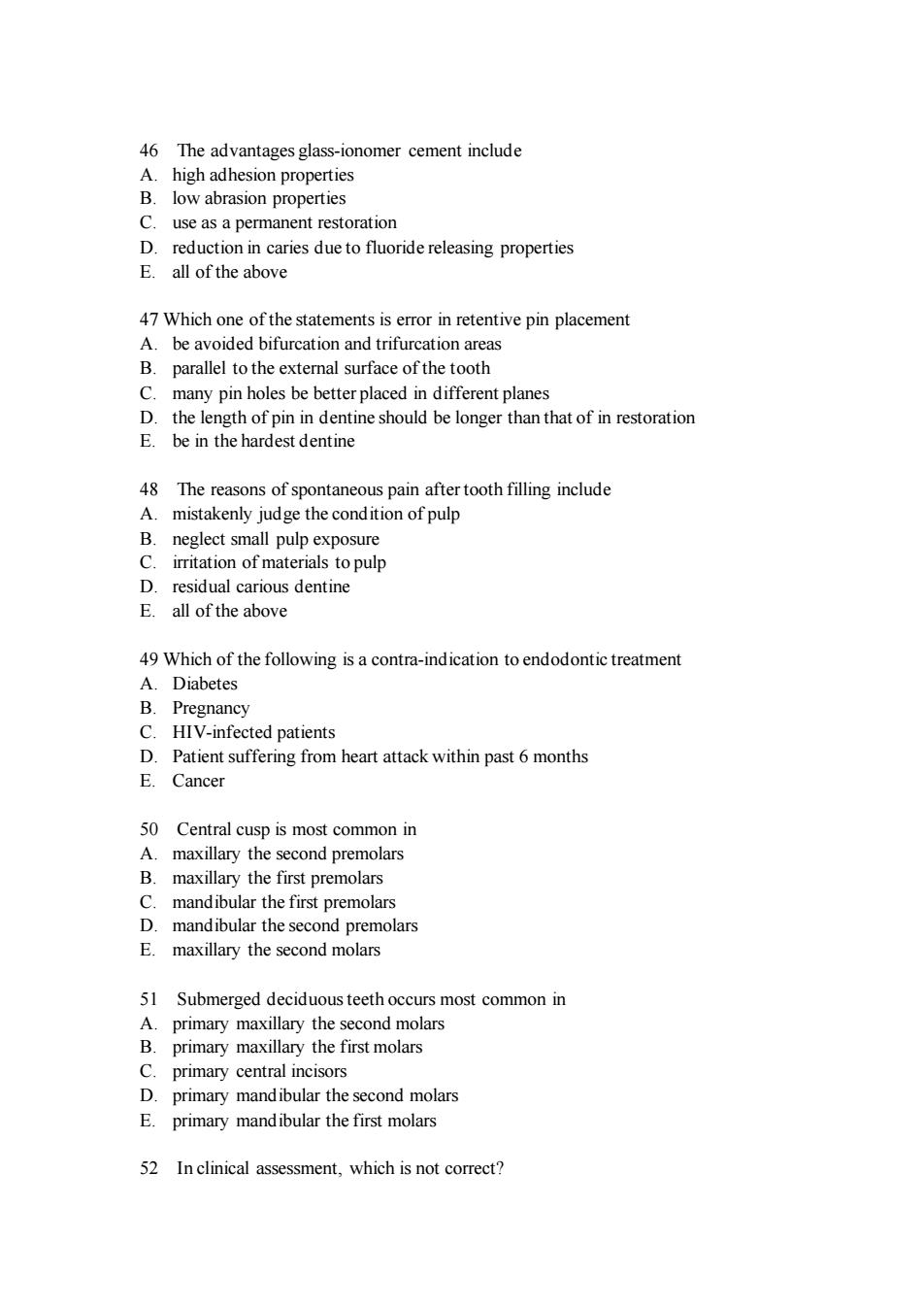
46 The advantages glass-ionomer cement include A.high adhesion properties B.low abrasion properties C.use as a permanent restoration D.reduction in caries due to fluoride releasing properties E.all of the above 47 Which one of the statements is error in retentive pin placement A.be avoided bifurcation and trifurcation areas B.parallel to the external surface of the tooth C.many pin holes be better placed in different planes D.the length of pin in dentine should be longer than that of in restoration E.be in the hardest dentine 48 The reasons of spontaneous pain after tooth filling include A.mistakenly judge the condition of pulp B.neglect small pulp exposure C. irritation of materials to pulp D.residual carious dentine E.all of the above 49 Which of the following is a contra-indication to endodontic treatment A.Diabetes B.Pregnancy C.HIV-infected patients D.Patient suffering from heart attack within past 6 months E.Cancer 50 Central cusp is most common in A.maxillary the second premolars B.maxillary the first premolars C.mandibular the first premolars D.mandibular the second premolars E.maxillary the second molars 51 Submerged deciduous teeth occurs most common in A.primary maxillary the second molars B.primary maxillary the first molars C.primary central incisors D.primary mandibular the second molars E.primary mand ibular the first molars 52 In clinical assessment,which is not correct?
46 The advantages glass-ionomer cement include A. high adhesion properties B. low abrasion properties C. use as a permanent restoration D. reduction in caries due to fluoride releasing properties E. all of the above 47 Which one of the statements is error in retentive pin placement A. be avoided bifurcation and trifurcation areas B. parallel to the external surface of the tooth C. many pin holes be better placed in different planes D. the length of pin in dentine should be longer than that of in restoration E. be in the hardest dentine 48 The reasons of spontaneous pain after tooth filling include A. mistakenly judge the condition of pulp B. neglect small pulp exposure C. irritation of materials to pulp D. residual carious dentine E. all of the above 49 Which of the following is a contra-indication to endodontic treatment A. Diabetes B. Pregnancy C. HIV-infected patients D. Patient suffering from heart attack within past 6 months E. Cancer 50 Central cusp is most common in A. maxillary the second premolars B. maxillary the first premolars C. mandibular the first premolars D. mandibular the second premolars E. maxillary the second molars 51 Submerged deciduous teeth occurs most common in A. primary maxillary the second molars B. primary maxillary the first molars C. primary central incisors D. primary mandibular the second molars E. primary mandibular the first molars 52 In clinical assessment, which is not correct?
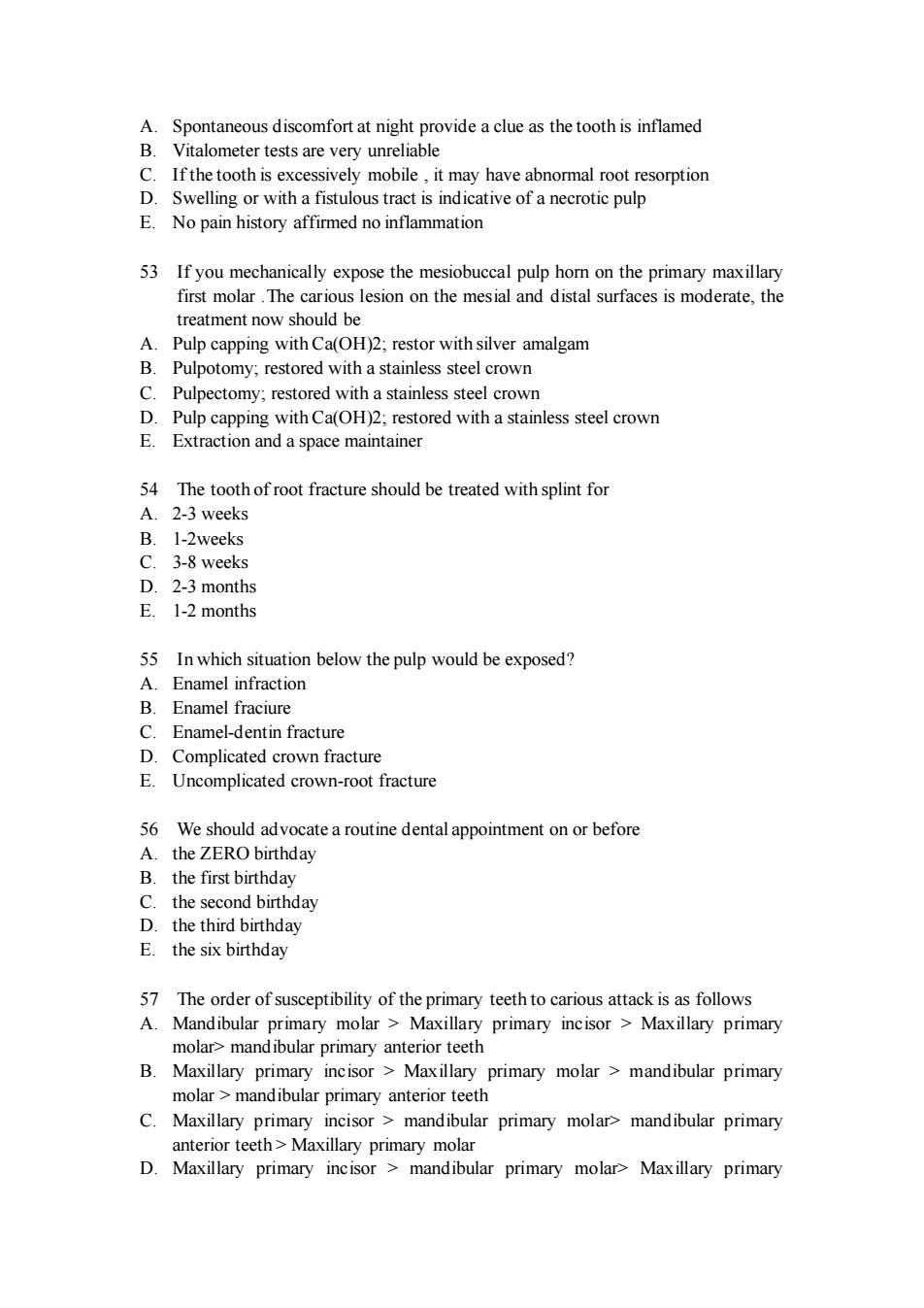
A.Spontaneous discomfort at night provide a clue as the tooth is inflamed B.Vitalometer tests are very unreliable C.If the tooth is excessively mobile,it may have abnormal root resorption D.Swelling or with a fistulous tract is indicative of a necrotic pulp E.No pain history affirmed no inflammation 53 If you mechanically expose the mesiobuccal pulp horn on the primary maxillary first molar.The carious lesion on the mesial and distal surfaces is moderate,the treatment now should be A.Pulp capping with Ca(OH)2;restor with silver amalgam B.Pulpotomy;restored with a stainless steel crown C.Pulpectomy;restored with a stainless steel crown D.Pulp capping with Ca(OH)2;restored with a stainless steel crown E.Extraction and a space maintainer 54 The tooth of root fracture should be treated with splint for A.2-3 weeks B.1-2weeks C.3-8 weeks D.2-3 months E.1-2 months 55 In which situation below the pulp would be exposed? A. Enamel infraction B.Enamel fraciure C. Enamel-dentin fracture D.Complicated crown fracture E.Uncomplicated crown-root fracture 56 We should advocate a routine dental appointment on or before A.the ZERO birthday B.the first birthday C.the second birthday D.the third birthday E.the six birthday 57 The order of susceptibility of the primary teeth to carious attack is as follows A.Mandibular primary molar Maxillary primary incisor Maxillary primary molar>mandibular primary anterior teeth B.Maxillary primary incisor Maxillary primary molar mandibular primary molar mandibular primary anterior teeth C.Maxillary primary incisor mandibular primary molar>mandibular primary anterior teeth>Maxillary primary molar D.Maxillary primary incisor mandibular primary molar>Maxillary primary
A. Spontaneous discomfort at night provide a clue as the tooth is inflamed B. Vitalometer tests are very unreliable C. If the tooth is excessively mobile , it may have abnormal root resorption D. Swelling or with a fistulous tract is indicative of a necrotic pulp E. No pain history affirmed no inflammation 53 If you mechanically expose the mesiobuccal pulp horn on the primary maxillary first molar .The carious lesion on the mesial and distal surfaces is moderate, the treatment now should be A. Pulp capping with Ca(OH)2; restor with silver amalgam B. Pulpotomy; restored with a stainless steel crown C. Pulpectomy; restored with a stainless steel crown D. Pulp capping with Ca(OH)2; restored with a stainless steel crown E. Extraction and a space maintainer 54 The tooth of root fracture should be treated with splint for A. 2-3 weeks B. 1-2weeks C. 3-8 weeks D. 2-3 months E. 1-2 months 55 In which situation below the pulp would be exposed? A. Enamel infraction B. Enamel fraciure C. Enamel-dentin fracture D. Complicated crown fracture E. Uncomplicated crown-root fracture 56 We should advocate a routine dental appointment on or before A. the ZERO birthday B. the first birthday C. the second birthday D. the third birthday E. the six birthday 57 The order of susceptibility of the primary teeth to carious attack is as follows A. Mandibular primary molar > Maxillary primary incisor > Maxillary primary molar> mandibular primary anterior teeth B. Maxillary primary incisor > Maxillary primary molar > mandibular primary molar > mandibular primary anterior teeth C. Maxillary primary incisor > mandibular primary molar> mandibular primary anterior teeth > Maxillary primary molar D. Maxillary primary incisor > mandibular primary molar> Maxillary primary
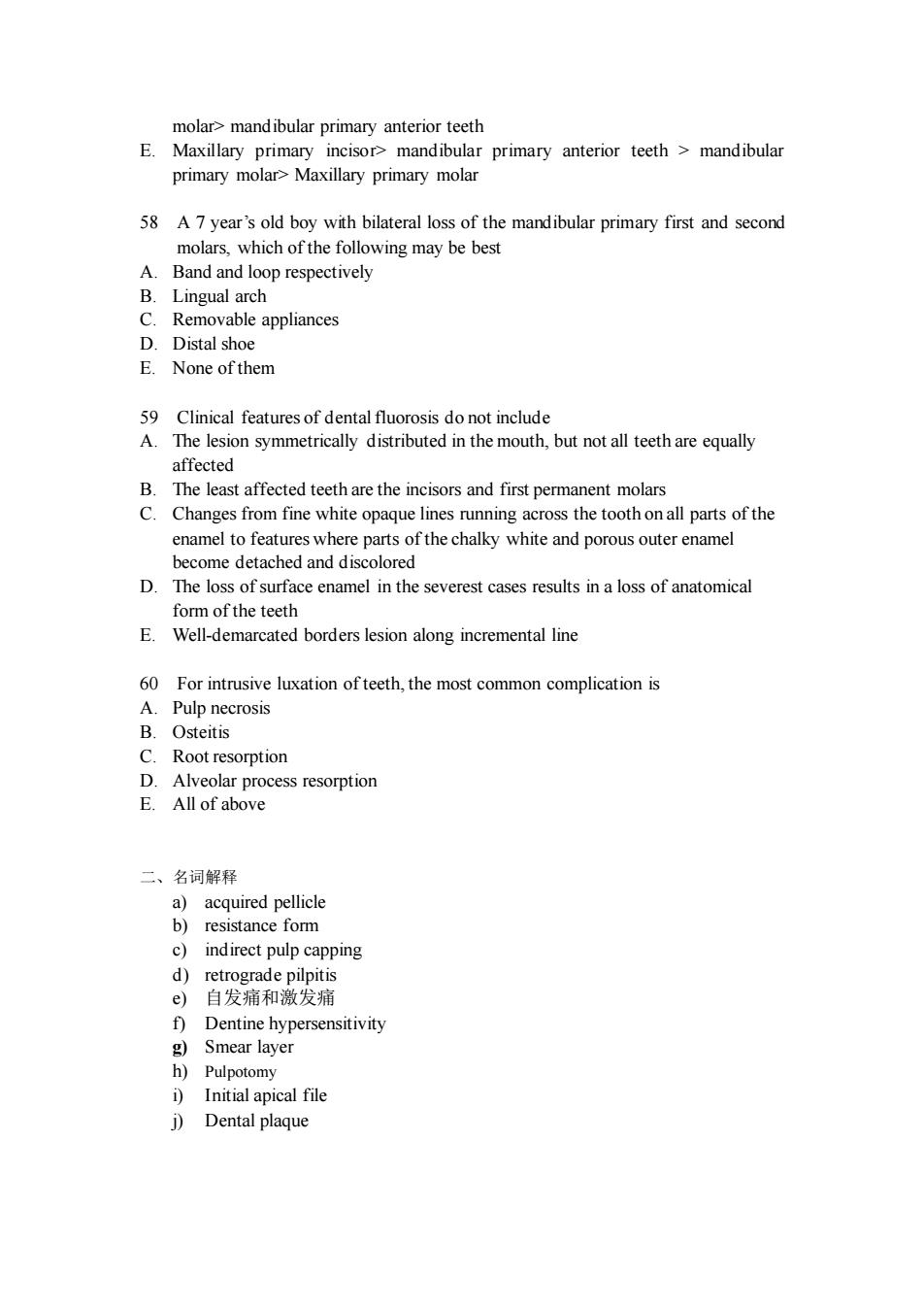
molar>mand ibular primary anterior teeth E.Maxillary primary incisor>mandibular primary anterior teeth mandibular primary molar>Maxillary primary molar 58 A 7 year's old boy with bilateral loss of the mandibular primary first and second molars,which of the following may be best A.Band and loop respectively B.Lingual arch C.Removable appliances D.Distal shoe E.None ofthem 59 Clinical features of dental fluorosis do not include A.The lesion symmetrically distributed in the mouth,but not all teeth are equally affected B.The least affected teeth are the incisors and first permanent molars C.Changes from fine white opaque lines running across the tooth on all parts of the enamel to features where parts of the chalky white and porous outer enamel become detached and discolored D.The loss of surface enamel in the severest cases results in a loss of anatomical form of the teeth E.Well-demarcated borders lesion along incremental line 60 For intrusive luxation of teeth,the most common complication is A.Pulp necrosis B.Osteitis C. Root resorption D.Alveolar process resorption E.All of above 二、名词解释 a)acquired pellicle b)resistance form c)indirect pulp capping d)retrograde pilpitis e)自发痛和激发痛 f)Dentine hypersensitivity g)Smear layer h)Pulpotomy i)Initial apical file j)Dental plaque
molar> mandibular primary anterior teeth E. Maxillary primary incisor> mandibular primary anterior teeth > mandibular primary molar> Maxillary primary molar 58 A 7 year’s old boy with bilateral loss of the mandibular primary first and second molars, which of the following may be best A. Band and loop respectively B. Lingual arch C. Removable appliances D. Distal shoe E. None of them 59 Clinical features of dental fluorosis do not include A. The lesion symmetrically distributed in the mouth, but not all teeth are equally affected B. The least affected teeth are the incisors and first permanent molars C. Changes from fine white opaque lines running across the tooth on all parts of the enamel to features where parts of the chalky white and porous outer enamel become detached and discolored D. The loss of surface enamel in the severest cases results in a loss of anatomical form of the teeth E. Well-demarcated borders lesion along incremental line 60 For intrusive luxation of teeth, the most common complication is A. Pulp necrosis B. Osteitis C. Root resorption D. Alveolar process resorption E. All of above 二、名词解释 a) acquired pellicle b) resistance form c) indirect pulp capping d) retrograde pilpitis e) 自发痛和激发痛 f) Dentine hypersensitivity g) Smear layer h) Pulpotomy i) Initial apical file j) Dental plaque